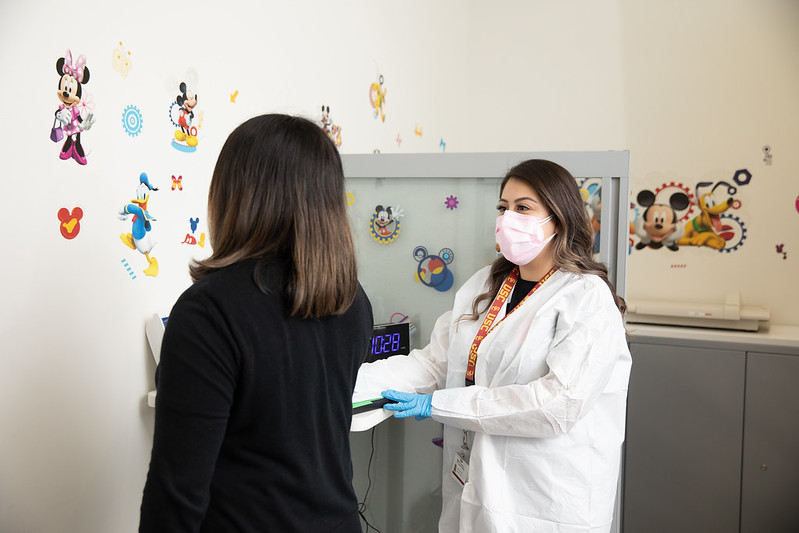Research Highlights:
- In an analysis of health data for pregnant Hispanic/Latina women in Los Angeles, the likelihood of having a preeclampsia diagnosis (a serious and sometimes fatal pregnancy complication that combines high blood pressure and signs of organ damage) was higher among women who followed a diet relatively high in solid fats, refined grains and cheese during their third trimester of pregnancy.
- The likelihood of a preeclampsia diagnosis was lower among pregnant women who ate diets relatively rich in non-starchy vegetables, oils and fruit.
- And, more than one in 5 women in the study developed at least one hypertensive disorder of pregnancy.
- The results suggest that dietary counseling may help reduce and possibly prevent certain pregnancy complications among Hispanic/Latina women.
Embargoed until 9:30 a.m. CT/10:30 a.m. ET Thursday, March 3, 2022

 (NewMediaWire) – March 03, 2022 – DALLAS – Diet may play a role in the development of dangerous high blood pressure in late pregnancy among some Hispanic/Latina women, according to preliminary research to be presented at the American Heart Association’s Epidemiology, Prevention, Lifestyle & Cardiometabolic Health Conference 2022. The meeting will be held in person in Chicago and virtually Tuesday, March 1 – Friday, March 4, 2022, and offers the latest in population-based science related to the promotion of cardiovascular health and the prevention of heart disease and stroke.
(NewMediaWire) – March 03, 2022 – DALLAS – Diet may play a role in the development of dangerous high blood pressure in late pregnancy among some Hispanic/Latina women, according to preliminary research to be presented at the American Heart Association’s Epidemiology, Prevention, Lifestyle & Cardiometabolic Health Conference 2022. The meeting will be held in person in Chicago and virtually Tuesday, March 1 – Friday, March 4, 2022, and offers the latest in population-based science related to the promotion of cardiovascular health and the prevention of heart disease and stroke.
“Our study findings suggest that a diet with relatively higher intakes of non-starchy vegetables, oils and fruit may lower the likelihood of developing a high blood pressure disorder during pregnancy, among our study group of predominantly low-income Hispanic/Latina women. Conversely a diet with relatively higher intakes of solid fat, refined grains and cheese may increase the likelihood of a diagnosis of a serious condition, called preeclampsia,” said lead author of the study, Luis E. Maldonado, Ph.D., M.P.H., a postdoctoral scholar and research associate in the department of population and public health sciences at the Keck School of Medicine at the University of Southern California in Los Angeles.
Hispanic/Latina women are among several racial and ethnic groups at higher risk of developing blood pressure disorders during pregnancy. Hypertensive disorders of pregnancy (HDPs) include gestational hypertension (developing high blood pressure for the first time after the 20th week of pregnancy) and preeclampsia, a serious and sometimes fatal late-pregnancy complication that includes high blood pressure with signs of damage to the liver and kidneys.
In this study, researchers sought possible links between what women typically ate in the third trimester of pregnancy (the last three months of pregnancy, months 7, 8 and 9) and the diagnosis of hypertensive disorders of pregnancy. They analyzed data on 464 pregnant women (average age of 29 years) who were already participating in research through the Maternal and Developmental Risks from Environmental and Social Stressors (MADRES) Center, an ongoing, prospective pregnancy cohort of predominantly low-income, Hispanic/Latina women living in Los Angeles. The study included women who had normal blood pressure prior to pregnancy and women who had been diagnosed with hypertension prior to pregnancy who may develop worsening high blood pressure conditions during pregnancy.
Using the Automated Self-Administered 24-Hour Dietary Assessment Tool (ASA24), a self-administered, web-based tool, freely available for use in large-scale nutrition research, each woman verbally completed one or more dietary recalls during their third trimester of pregnancy that asked about foods and beverages consumed in the previous 24-hour period. Based on participants’ responses regarding their food intake, scores were calculated for each woman for two different dietary patterns:
- Participants scoring in the upper quartile of a diet with relatively higher intakes of solid fats, refined grains and cheese were classified as following the SRC dietary pattern. To a lesser extent, the SRC dietary pattern was also associated with more added sugar, meats and processed meats.
- Participants scoring in the upper quartile of a diet with relatively higher intakes of non-starchy vegetables, oils (fats naturally present in nuts, seeds, seafood; non-hydrogenated vegetable oils, etc.) and fruit were classified as following a VOF dietary pattern. The VOF dietary pattern was also associated with greater consumption of nuts and seeds, yogurt, whole grains, eggs, soy protein and seafood.
The diagnosis of hypertension was determined from the women’s medical charts, noting either a physician’s diagnosis or a blood pressure reading (after 20 weeks of pregnancy) of 140 mm Hg or higher systolic (the top number) or 90 mm Hg or higher diastolic (the bottom number) on at least two consecutive prenatal visits. The results were adjusted for age, education, Hispanic/Latina ethnicity, number of pregnancies, pre-pregnancy diabetes and daily calorie consumption.
The analysis found:
- 21.6% of the women developed at least one hypertensive disorder of pregnancy, with 6.7% developing gestational hypertension and 12.1% developing preeclampsia.
- Women who scored in the upper 25% on the dietary pattern consuming the most solid fats, refined grains and cheese (the SRC dietary pattern) had 3.50 greater likelihood of having had any hypertensive disorder of pregnancy and 3.59 greater likelihood of having had a preeclampsia diagnosis, compared with women who reported eating the least of these foods (in the lowest 25% on the SRC dietary pattern).
- Women who reported consuming the most non-starchy vegetables, oils and fruits (those who scored in the upper 25% on the VOF dietary pattern) had a lower likelihood of having developed preeclampsia (0.33) compared with women eating the least of the foods in the VOF dietary pattern.
The study has several limitations. The dietary data was self-reported and relied on participant memory. Maldonado noted these results may not be generalizable to all populations since study participants were predominantly low-income and of Hispanic/Latina origin. Therefore, foods more culturally relevant and commonly consumed by the study population may be different in other populations.
“Additionally, the women’s diets were assessed only at one point in time, and mostly in the third trimester of pregnancy, which may have been either before or after a hypertensive disorder of pregnancy was diagnosed,” Maldonado said. “The timing is important because individuals may change their diet and other health behaviors as a result of any other serious health-related diagnosis such as gestational diabetes or high blood pressure. Therefore, future studies that capture diet earlier in pregnancy and before a hypertensive disorder of pregnancy diagnosis is made are needed to verify our findings.”
Co-authors are Claudia M. Toledo-Corral, Ph.D., M.P.H.; Genevieve F. Dunton, Ph.D, M.P.H.; Shohreh Farzan, Ph.D.; Carrie V. Breton, Sc.D.; and Theresa M. Bastain, Ph.D., M.P.H. Authors’ disclosures are listed in the abstract.
The study was funded by the Maternal and Developmental Risks from Environmental and Social Stressors (MADRES) Center at USC, the Southern California Environmental Health Sciences Center, the Life Course Approach to Developmental Repercussions of Environmental Agents on Metabolic and Respiratory Health and the National Institutes of Health Office of the Director of the Environmental Influences on Child Health Outcomes (ECHO) Program.
NOTE: Presentation time of this oral abstract is 9:30 a.m. CT/10:30 a.m. ET Thursday, March 3, 2022.
Statements and conclusions of studies presented at the American Heart Association’s scientific meetings are solely those of the study authors and do not necessarily reflect the Association’s policy or position. The Association makes no representation or guarantee as to their accuracy or reliability. Abstracts presented at the Association’s scientific meetings are not peer-reviewed, rather, they are curated by independent review panels and are considered based on the potential to add to the diversity of scientific issues and views discussed at the meeting. The findings are considered preliminary until published as a full manuscript in a peer-reviewed scientific journal.
The Association receives funding primarily from individuals; foundations and corporations (including pharmaceutical, device manufacturers and other companies) also make donations and fund specific Association programs and events. The Association has strict policies to prevent these relationships from influencing the science content. Revenues from pharmaceutical and biotech companies, device manufacturers and health insurance providers and the Association’s overall financial information are available here.
Additional Resources:
The American Heart Association’s EPI/LIFESTYLE 2022 Scientific Sessions is the world’s premier meeting dedicated to the latest advances in population-based science. The meeting is in-person in Chicago and virtually, Tuesday, March 1 – Friday, March 4, 2022. The meeting is focused on promoting the development and application of translational and population science to prevent heart disease and stroke and foster cardiovascular health. The sessions focus on risk factors, obesity, nutrition, physical activity, genetics, metabolism, biomarkers, subclinical disease, clinical disease, healthy populations, global health and prevention-oriented clinical trials. The Councils on Epidemiology and Prevention and Lifestyle and Cardiometabolic Health (Lifestyle) jointly plan the EPI/Lifestyle 2022 Scientific Sessions. Follow the conference on Twitter at #EPILifestyle22.
About the American Heart Association
The American Heart Association is a relentless force for a world of longer, healthier lives. We are dedicated to ensuring equitable health in all communities. Through collaboration with numerous organizations, and powered by millions of volunteers, we fund innovative research, advocate for the public’s health and share lifesaving resources. The Dallas-based organization has been a leading source of health information for nearly a century. Connect with us on heart.org, Facebook, Twitter or by calling 1-800-AHA-USA1.
###
For Media Inquiries and AHA Expert Perspective:
AHA Communications & Media Relations in Dallas: 214-706-1173; ahacommunications@heart.org
Cathy Lewis: cathy.lewis@heart.org
For Public Inquiries: 1-800-AHA-USA1 (242-8721)
heart.org and stroke.org
